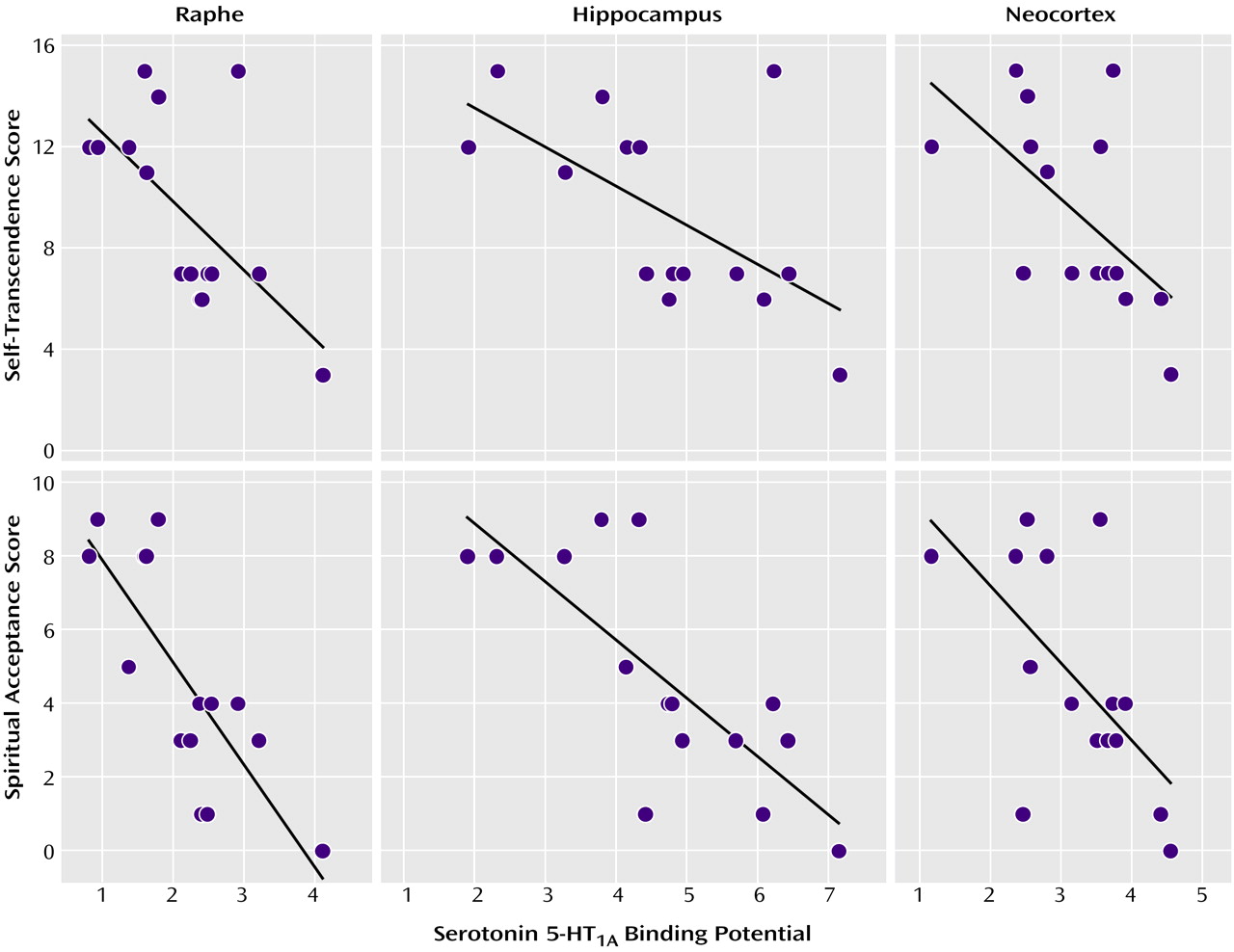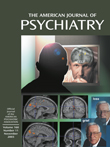Religious behavior, like other human behavior, varies widely among individuals. There is increasing support for the view that such interindividual differences can be explained by biological and genetic factors. A role for the serotonin system was suggested early on from subjective experiences induced by mind-altering drugs, such as LSD and psilocybin.
Central serotonergic neurons originate from the raphe nuclei in the brainstem and innervate major brain regions, such as the hypothalamus, the limbic system, the striatum, and the neocortex. Fourteen serotonin receptor subtypes have thus far been identified in the human brain
(1). The most extensively investigated is the serotonin 5-HT
1A receptor. Presynaptic 5-HT
1A autoreceptors are highly concentrated on cell bodies in the raphe and mediate the inhibition of cell firing and serotonin release in all projection areas. Thus, the 5-HT
1A receptor may have a role as general regulator of serotonergic activity. In human subjects, the 5-HT
1A receptor can be examined in vivo by using position emission tomography (PET) and the radioligand [
11C]WAY100635
(2).
Initial PET studies with [
11C]WAY100635 have shown that 5-HT
1A receptor density varies more than twofold in normal subjects
(6). Given this interindividual variability, we here used an open explorative design to search for associations between 5-HT
1A receptor density and personality traits. The Temperament and Character Inventory
(7) was used to assess personality dimensions.
Results
Among the 15 subjects, the binding potential of [11C]WAY100635 to 5-HT1A receptors varied markedly and was between 0.81 and 4.11 (mean=2.17, SD=0.87) for the raphe, 1.91 and 7.15 (mean=4.68, SD=1.49) for the hippocampus, and 1.60 and 4.55 (mean=3.21, SD=0.90) for the neocortex. The between-subject variability in levels of 5-HT1A receptor binding potential was maintained across the three regions examined; Spearman’s correlation for the neocortex versus the hippocampus was rs=0.86, p=0.00004, for the neocortex versus the raphe, rs=0.65, p=0.009, and for hippocampus versus the raphe, rs=0.86, p=0.00004.
The values for binding potential correlated significantly with the self-transcendence dimension but not with any of the other six Temperament and Character Inventory dimensions (
Table 1). The self-transcendence dimension is a composite of three distinct subscales that describe aspects of spirituality. After the demonstration of statistical significance for the self-transcendence dimension, correlations for each of the dimension’s three subscales were examined. Scores for spiritual acceptance versus material rationalism correlated significantly with 5-HT
1A binding potential for all three regions (
Figure 1). No significant correlations were found for any of the remaining two subscales (
Table 1).
Discussion
In the present study, we found an association between interindividual variability in 5-HT
1A receptor binding potential and the self-transcendence score on the Temperament and Character Inventory. We found no correlation for any of the other dimensions. The lack of correlation for the other dimensions is consistent with a previous study that used Tridimensional Personality Questionnaire, and an earlier questionnaire covering the four temperament dimensions of the Temperament and Character Inventory
(6).
The self-transcendence dimension is the most stable Temperament and Character Inventory dimension over time and is also one of the two Temperament and Character Inventory dimensions showing the largest variability
(13). The self-transcendence dimension consists of three subscales representing several aspects of religious behavior, subjective experience, and individual worldview. Of interest, in the extended analysis, we found that the correlation of self-transcendence was shown to be fully dependent on the spiritual acceptance scale, whereas no correlation was found to the other two subscales.
The spiritual acceptance scale measures a person’s apprehension of phenomena that cannot be explained by objective demonstration. Subjects with high scores tend to endorse extrasensory perception and ideation, whether named deities or a commonly unifying force. Low scorers, by contrast, tend to favor a reductionistic and empirical worldview
(15).
A role for the serotonin system in relation to spiritual experiences is supported by observations of drugs such as LSD, psilocybin,
N,N-dimethyltryptamine, mescaline, and 3,4-methylenedioxymethamphetamine that are known to cause perturbations of the serotonin system in several brain regions
(16–
18).
On a behavioral level, these drugs elicit perceptual distortions, illusions, a sense of insight, spiritual awareness, mystical experiences, and religious ecstasy. Of interest, such pharmacological effects induced by hallucinogens resemble the extrasensory perception and ideation endorsed by subjects scoring high on the spiritual acceptance scale.
However, another drug causing spiritual experiences is salvatorin A. This drug may act primarily on the kappa opioid receptor system
(19), indicating that the serotonin system is not the only brain neurotransmitter system that may be related to spiritual experiences.
The between-subject variability in levels of 5-HT1A receptor binding potential were maintained across all regions examined. In subjects with high spiritual acceptance scores, a key question is whether the observation of low 5-HT1A receptor levels corresponds to low or high activity in serotonergic cortical projection areas. Currently, the literature provides support for both interpretations.
If receptor density serves as a marker for neuron number, low 5-HT
1A receptor density may represent sparse serotonergic innervation. On a functional level, the effect of globally low serotonin has been examined using the tryptophan hydroxylase inhibitor
p-chlorophenylalanine
(20), a drug that impairs serotonin synthesis and release in all brain regions. Animal studies have shown that p-chlorophenylalanine induces greater sensitivity to sensory stimuli and facilitates greater arousal and unspecific aggressive behavior
(21). These observations support the hypothesis that the physiological role of the serotonin system includes inhibition of sensory stimuli and arousal. Low serotonin activity may thus pave the way for sensory stimuli otherwise not experienced. One interpretation of the present finding is that subjects with low 5-HT
1A receptor density have sparse serotonergic innervation and thereby a weaker filtering function, allowing for increased perception and decreased inhibition.
Another interpretation is that globally low density of 5-HT1A receptors is associated with greater postsynaptic activity. The 5-HT1A autoreceptors in the raphe modulate cell firing and serotonin release. Low expression of 5-HT1A autoreceptor in the raphe may thus accordingly correspond to high release of serotonin in projection areas.
These findings may have implications for the pathophysiology of several psychiatric conditions. Clinical studies have demonstrated that extreme scores in any direction on the self-transcendence scale can reflect individuals with impairment in social interaction and adaptation to society
(22,
23). Furthermore, delusions and hallucinations with religious content have been reported in neuropsychiatric disorders such as bipolar mania, schizophrenia, and complex seizure disorder
(24). The findings of the present study may provide additional support for current hypotheses on a role for the serotonin system in the pathophysiology of these disorders.
A limitation of the study is that the study group included male subjects only. Gender differences in religious behavior have been reported in several studies and documented by use of the Temperament and Character Inventory
(25,
26). Previous PET studies have not supported a statistically significant difference between men and women in 5-HT
1A receptor density. However, a difference in the age effect on 5-HT
1A receptor density has been reported in two studies
(27,
28) that supported age-related gender differences in binding potential. Therefore, caution must be exercised when generalizing the present finding in male subjects to the female population.
Another limitation of this study is the small group size. However, with the exception of the harm avoidance scale, a scale that consistently has shown large variation, the means and standard deviations of the present scores on the Temperament and Character Inventory were close to results from Swedish normative data, thereby suggesting that the study group was representative. The Swedish version of the Temperament and Character Inventory has been demonstrated to replicate the American version for means, distribution of scores, and relationships between scales and subscales, except for the self-transcendence scale
(13). Here, the Swedish normative sample showed lower values than the U.S. normative sample. This is believed to reflect cultural differences between the Swedish and U.S. populations.
A common view is that variability in religious behavior among people is determined by environmental and cultural differences. However, a twin and adoption study has reported that genetic variation contributes to about 50% of individual variation in religiosity
(29), thereby suggesting a biological underpinning. The findings of the present study may provide support for a biological underpinning specifically related to the central serotonergic system. Whereas experimental studies support a relationship between serotonin related gene polymorphisms and expression of 5-HT
1A receptors
(30), a genetic basis for interindividual variability in 5-HT
1A receptor density remains to be confirmed in humans.



